How to finish the walls in the bathroom - all possible materials
Morning shower or relaxing evening treatments - all this is so important for our mood and even well-being. This is why bathroom design is so important. Good plumbing, beautiful and functional furniture, harmoniously selected finishing materials ... By the way, it is with the latter that we will have to deal especially closely, because this part of the repair will be the most time-consuming.
How to decorate the walls in the bathroom so that it looks spectacular and does not require frequent updates?
To answer this question, you need to remember that the main feature of this room is a high level of humidity. In most apartments, if you do not take houses with a specific layout (), this room can be divided into three zones: for washing, for taking baths, a dressing room - there may be lockers, a washing machine, a laundry basket and other interior elements.
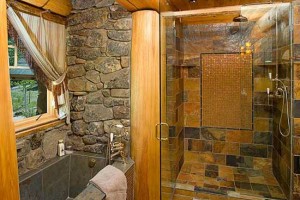
bathroom wall decoration
Where we take a shower, the walls are exposed to the active influence of water, respectively, materials with maximum water resistance are needed here.
In the wash area, the wall surface suffers from splashes, so a relatively water-resistant finish is needed.
But in the locker room, you can decorate the walls with something moisture resistant, water-repellent properties are no longer so important here.
Bathroom wall options
As a finish for the bathroom, you can offer the following options:
- ceramic tiles - has a 100% water resistance level, suitable for all areas;
- porcelain stoneware - also 100% waterproof, but heavier, which complicates the work;
- paint - some types have high, even 100% water resistance, or at least moisture resistance suitable for the locker room area. We will dwell on each specific type later;
- wallpapers - among the variety offered by manufacturers, you can find 100% waterproof and with a high degree of resistance to splashes and high humidity;
- wall panels - they are made from a variety of materials, and it depends on what and what area can be finished;
- mosaic - quite suitable even for the washing area, but again it all depends on what exactly it is made of;
- artificial and natural stone - if you do not take into account limestone and some other hygroscopic types of stone, then this is an excellent operational, although expensive option for the bathroom.
To finally decide how to finish the walls in the bathroom, it is worth dwelling on each type of material in more detail.
Video about modern bathroom decoration:
Ceramic tile
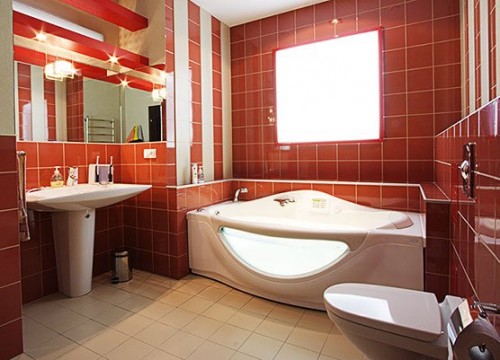
ceramic tile looks very neat
The undisputed classic of the genre is ceramic tiling. Of course, glazed is most suitable - it is 100% waterproof, it can be used in all three zones.
There are no complaints about aesthetic characteristics either: the choice in stores is simply huge, and using decorative inserts - panels, mosaics, mirrors - you can get just a unique design.
Laying tiles on the walls with your own hands is also not difficult. Elementary instruction:
- remove the old coating;
- align the walls;
- primed with compounds with waterproofing and antifungal properties;
- if necessary, we create additional waterproofing with mastics;
- apply tile adhesive to the wall;
- using the level and restrictive crosses lay out the tiles;
- we overwrite the seams;
- we process the seams with sealants such as "Dolphin".
If you have a small bathroom, then the work is unlikely to take more than two days. No auxiliary tools are required, tiles are inexpensive (if they are not designer), so this is the fastest, most economical and durable finishing option.
Porcelain stoneware
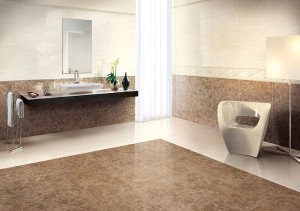 Like tiles, porcelain stoneware is 100% waterproof - the percentage of water absorption is less than 0.05.
Like tiles, porcelain stoneware is 100% waterproof - the percentage of water absorption is less than 0.05.
It is very resistant to impact, abrasion, and can be washed with any standard household products, even abrasive ones, so it is a smart choice for any area in the bathroom.
True, in an aesthetic sense, it is a little more meager, but if you turn on your artistic abilities, you can achieve simply amazing results. The laying principle is the same as for ceramic tiles.
Mosaic
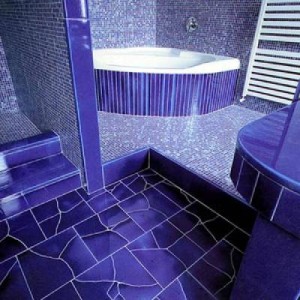 The concept of "mosaic" is very capacious. Today, under this name, a variety of materials are sold, which are united only by the fact that these are small pieces that can be attached to tile adhesive.
The concept of "mosaic" is very capacious. Today, under this name, a variety of materials are sold, which are united only by the fact that these are small pieces that can be attached to tile adhesive.
There is a mosaic made of ceramic tiles, fragments of pottery, glass, smalt, mirrors, pebbles, as well as from a wide variety of improvised materials.
From this range you can pick up something 100% waterproof. It is only necessary to carefully process the base and choose an adhesive that will not absorb moisture, and, if possible, close the seams with a reliable sealant.
In an artistic sense, the mosaic is simply magnificent: you can create real paintings on the entire wall, turn the bathroom into a design miracle. However, this is a very laborious, painstaking work, so this type of finish is usually used in the form of small inserts.
Wallpaper
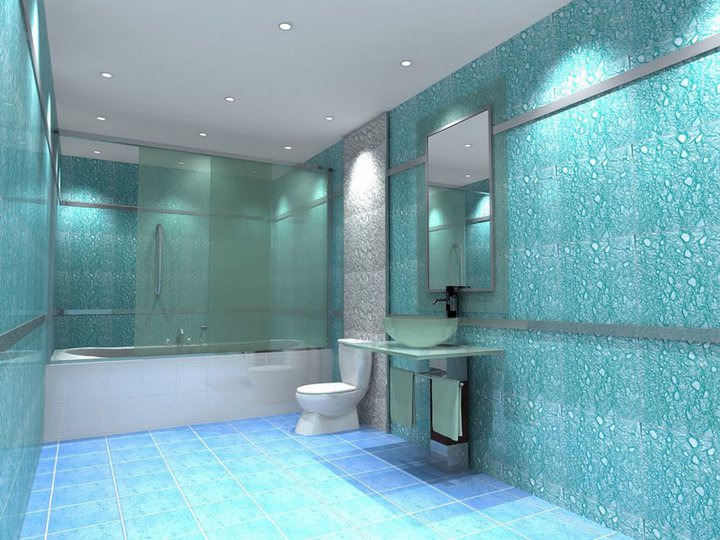
Listing the whole variety of materials, united under the general name "wallpaper", will take a very long time.
All paper-based varieties, even those with applied water-repellent compounds and films, marked with the “super washable” icon, can be immediately dismissed: it won’t even take six months before they swell, begin to lag behind the walls, crack, and so on.
Vinyl and the so-called liquid, and even more so woven varieties, despite numerous recommendations, in fact, also turn out to be not very viable when exposed to steam, water, and detergents. However, there are some interesting options.
- Glass fiber. They are actually made of fiberglass, so they are completely impervious to water. They can be washed by any means, they are resistant to abrasion, so they can be considered practically eternal.
- Non-woven. Can be used in the wash area and in the locker room, they are not suitable for the washroom.
Both of these types of wallpaper are usually unpatterned and are sold in a very limited range of colors. If they are painted, then use in the shower will no longer be possible due to the properties of the paints.
An important point: you need to carefully seal the walls before gluing so that water does not seep through them. It is also important to use special types of adhesives.
Painting
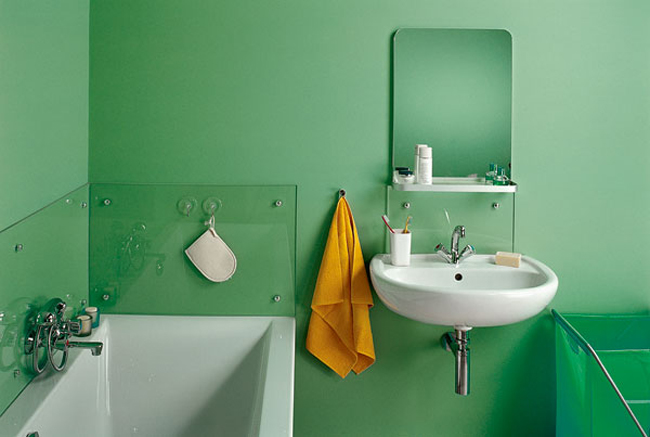
Thinking about how to finish the walls, many decide that painting is in every sense a great option. And they are wrong.
Firstly, any paint looks very poor. Secondly, before applying the finishing layer, laborious work will be done to level it to an ideal state, as well as to apply several layers of waterproof soil. Thirdly, not all colors are suitable.
You can use the following types of paints in the bathroom: water-based (only 100%, not with additions!) And chlorinated rubber. Alkyd and oil paints have a fairly persistent odor, and the latter is also unstable to detergents; PVA-based water-based paints are also not suitable.
Wall panels
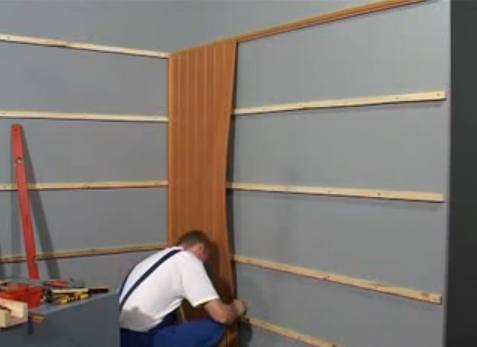
An excellent alternative to ceramic and porcelain tiles are wall panels - skinals, which have settled on the market not so long ago. Depending on the material of execution, they can be used in different areas:
- Finishing the toilet with plastic panels. They are quite fragile, but 100% resistant to water, are on the market in a variety of colors.
- From tempered glass. An excellent, albeit expensive, solution. Waterproof, not afraid of impacts, high temperatures, chemical exposure. Such panels with a decorative pattern look very impressive.
- Panels made of laminated wood chip materials. Well suited for the dressing room area, but you need to pay attention to sealing the seams.
- Postforming. The plastic-filled plate is more durable than conventional plastic panels. She can finish the wall in the wash area and the locker room.
The advantage of skinals lies in the very simple installation. However, we must not forget that even with very good sealing, condensate will still accumulate behind the panels, which must evaporate through some vents.
Video by :
Stone natural and artificial
 Finishing with stone slabs or small pebbles looks very stylish and respectable, however, you need to choose from the offered range those types that have minimal hygroscopicity and are resistant to acids and alkalis.
Finishing with stone slabs or small pebbles looks very stylish and respectable, however, you need to choose from the offered range those types that have minimal hygroscopicity and are resistant to acids and alkalis.
Installation work is somewhat difficult due to the large weight of such materials.
Other materials
The walls in the bathroom can also be finished:
- mirror mosaic or panels. It is important to choose a type of mirror that is resistant to moisture;
- plaster. Some types of plasters are suitable for the dressing room area;
- natural wood. There are moisture-resistant woods, such as larch, which, after appropriate processing, can be used in areas with high humidity.
Conclusion
In the bathroom, even with excellent ventilation, there is almost always very high humidity. In addition, alkaline or acidic detergents often get on the walls. So the choice of materials for wall decoration is very limited. The most preferred for the washing zone are:
- ceramic or porcelain tiles;
- mosaic based on ceramics or porcelain stoneware, tempered glass, smalt, mirrors;
- cullet;
- some types of water-based paints, chlorinated rubber compounds;
- skinali from plastic, tempered glass;
- mirrors;
- natural and artificial stone.
For the wash area, you can also use:
- non-woven wallpaper;
- postforming.
Of all the options listed, the most optimal is ceramic tiles or porcelain stoneware slabs. They have a relatively low cost, are 100% resistant to water, aggressive environments, are not susceptible to fungi, have excellent decorative effect and do not require great skill from the installer.






